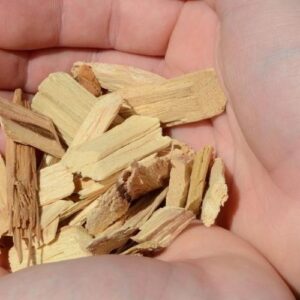
Salty soil? In the desert? Really?
Yes, really.
We have pretty hard water in Anthem and the greater Phoenix area, meaning that there are a lot of minerals dissolved in it. When the water dries (including in your soil), minerals such as calcium and magnesium carbonate come out of solution and turn into hard crystals – that’s the whitish buildup you see around faucets.
Those minerals are referred to as “salts.”
While salt is great around the rim of a margarita glass, when it gathers in soil you’ll start to see adverse effects (including death) in your plants and any trees that receive water from irrigation.
What Causes Salt to Build up in Desert Soil?
The biggest culprit in salt buildup is shallow, frequent watering.
Picture this: If you have an irrigation system (like most Anthem and Phoenix-area residents), it’s probably on a timer to water twice a day for short periods of time (especially during the summer). Or maybe you have small trees or shrubs that are on a drip irrigation line and get watered every few days.
These short watering times mean that the irrigation water does not percolate very far into the ground – often just to the root zone (or even above where the root zone would ideally be, leading to a shallow root system).
Over time, as the soil alternates between wet and dry as your irrigation system turns on and off, salts build up in your soil at the depth to which the irrigation water percolates. With shallow watering, the salts end up right in the root zone of your plants.
How Do I Know If My Plants Are Being Harmed by Salt Buildup?
The combination of salty soil, hard water that contains a lot of salts, and shallow watering will eventually mean trouble for your irrigated plants and trees.
Salt buildup most affects plants during the heat of summer, where plants and trees are taking up water much more quickly in an attempt to stay hydrated and cool (see transpiration).
Taking up extra water means that they’re taking up more of the mineral salts that come with it, as well as being affected by salt buildup in the surrounding soil. This is when you start to see the following symptoms:
- Leaves that look yellow or burned at the tips and edges
- Leaves falling off
- Wilting leaves
- Drooping stems
- Yellowing leaves with green veins (called chlorosis)
Wilting and chlorosis are signs that salt has built up in the soil to the point that it’s preventing the plant from absorbing water or taking up the nutrients it needs. Browning and leaf drop indicate that salt has built up within the plant itself, killing cells and tissues.
How Do I Get Rid of Salt Buildup?
The best way to remove salts from your desert soil is to flush them down through the soil to a point below the plant’s root zone.
Don’t count on our monsoon rains to do this job for you. Monsoon rains are usually hard and fast; rainwater flows off quickly, usually without being absorbed deep into the soil.
Give your plants a long, slow soak to move salt away from the root zone. This process is referred to as “leaching” (not to be confused with leeching, which is the medical practice of applying leeches) and there are several ways to do it.
Increase your irrigation system run time – You’ll probably need to water for at least 3 times longer than normal to make sure water continuously percolates below the plant’s root zone, taking salts with it. If in doubt, go longer.
Use a hose to trickle water around the plant – Place the hose end at the drip line of the plant (not up against the trunk!). Provide a slow stream of water for several hours, moving the hose from time to time to ensure you’ve flushed the entire area.
Build a basin around each plant and fill it with water – Use soil, sand or mulch to form a “wall” at the drip edge of the plant (or a little farther out) to hold back the water. You want water to cover the entire root area. Slowly fill the basin with water and let it drain (this could take a while). Repeat several times to completely flush the area. See the photo above for an example.
Not only will a long, slow soak flush salts from the soil, it will also encourage plant roots to grow deeper.
And don’t worry, you only need to do this 2-3x a year to keep salt buildup at bay so it won’t break the bank.
Ensure You’re Watering Your Trees Correctly
Mature, well-established trees need very little supplemental water, particularly if they’re native or desert adapted trees. However, they may appreciate a long, slow soak in July or August to help them cope with the summer heat.
Recently-planted, young and non-native trees will likely be on irrigation so will need to have salt flushed from the soil to avoid salt injury.
Remember, never water the trunk of a tree; that’s not where the roots are and that’s not where you want them to be. Instead, water by the drip line, or further out if you think that the roots have expanded past that. Contrary to popular belief, roots do not look just like the top of the tree underground. They spread out like a Frisbee, reaching maybe 3 feet deep. As they spread out, they anchor the tree into the ground, making it better able to withstand our strong monsoon winds. So water at least at the edge of where the tree canopy is.
If you are looking for reliable tree services, contact Titan Tree Care today!
See Our Latest Articles
More Articles Like This

Titan Tree Care is a full-service tree care company located in Anthem, AZ and serving all of North Phoenix. We offer a wide range of services to meet your tree care needs, including tree and palm trimming, tree pruning, tree removal, stump grinding, and more. We also offer insect or disease treatments and fertilization services. We are dedicated to providing high-quality, safe, and effective tree care services to our customers and work hard to ensure that your trees are healthy and look their best.









